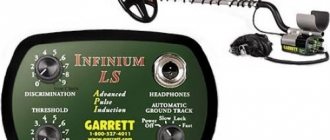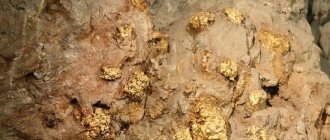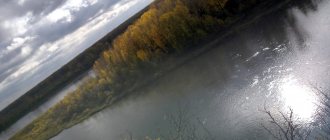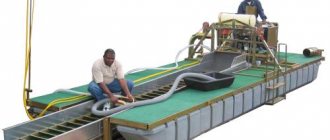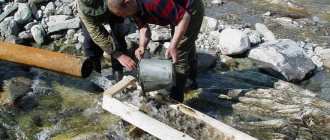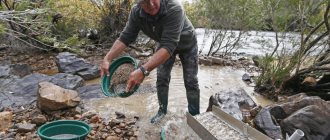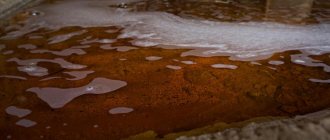If you have a special device - a metal detector or a search magnet, you can find gold lost by someone in crowded places.
Moreover, you can even find a treasure hidden by someone.
It is not necessary to know the exact location, because there are a huge variety of devices on the market for searching for gold and antiquities.
Now we will dot the i’s and decide on the technology for searching for precious metals and jewelry.
Choosing a metal detector
If your goal is gold, you should immediately discard metal detectors for beginners and semi-professionals.
For example,
FisherF5 is a middle-class device; it can easily detect a gold ring at 8-10 centimeters or an earring at 3-5 cm, but this is not an indicator at all.
When choosing from the Fisher brand, the best choice is the F 75 LimitedEdition . It is not being produced now; instead, the F 75 Black is being produced, although in essence the models are no different except for the color.
You can choose from used ones. But for this, when purchasing, you should take with you a person who understands metal detectors in order to protect yourself from unwanted consequences.
And here the most important thing is not the depth of the search, although this is also an important criterion.
With proper adjustment from the ground, he sees the ring from 20-25 centimeters, and the earring - about 10-15 cm. (cutting off signals from unwanted objects) is very important And the discriminator of this device is quite good.
This device is very sensitive - it responds very well to power lines and nearby metal detectors.
If you are going to work in a team, you should stay away from other search participants - at a distance of 4 - 6 meters. The device also swears a lot if power lines pass below 15 meters - you have to either turn off the sensitivity or leave the search site.
Clear advantages of the F75 LTD :
- good target detection depth;
- light weight (1600g);
- The battery charge is enough for 3-4 trips to the mine, low power consumption, and the ability to install regular AA batteries;
- perfectly distinguishes non-ferrous metals from ferrous ones;
- detects small objects well;
- high target response speed - you can operate the coil quite quickly and survey a larger area compared to other metal detectors.
Minuses:
- the sound is too disgusting, but over time you can get used to it;
- it is necessary to closely monitor the cable from the coil - because of it, detection of phantom (non-existent) targets is possible;
- as already noted, it reacts to other metal detectors and does not tolerate high-voltage lines due to the low operating frequency of 13 kHz.
In essence, this is just a very good high-level metal detector that does not have underwater search capabilities. The reel can be completely immersed in water, but the block is afraid of water .
If you intend to buy a universal metal detector with a high-quality discriminator and a wide range of searches in soils of varying mineralization, this device will be a faithful assistant.
From the Garrett line, we can recommend Garrett AT Gold . This device operates at a frequency of 18 kHz . You can be calm about whether it reacts to small targets, but, nevertheless, in this indicator the discriminator is inferior to Fisher.
A special advantage compared to its competitor is the ability to submerge the unit under water to a depth of 3 meters . Its price is half that of the Fisher75 LTD, and it is not as sensitive to high-voltage lines.
You can make a small upgrade to this device and increase the safety of the unit from water getting inside. To do this, you need to take a piece of thick, flat, rectangular plastic.
Then remove the cover on the block that covers the speaker and replace it with a rectangular piece of plastic, having previously lubricated the inside with silicone or sealant. Then place it on the screws.
Thanks to this simple procedure, you can add a dive meter , since the speaker is the most dangerous place during underwater searching.
The fact is that when diving 1 meter, the pressure per 1 sq. cm is 100 grams, which is why the speaker will simply burst from great depth.
After covering the speaker holes:
- there will be no ingress of salty sea water, which is an aggressive environment and has a negative effect on parts;
- there will be no need to empty this compartment of sand and any debris, of which there is plenty;
- your device will be much quieter, attracting fewer curious onlookers.
You can also build a metal detector with your own hands. Read about how to do this here (DIY metal detector for gold).
Promising gold-bearing regions in Russia
In search of gold crystals and nuggets, they consider the following territories:
- Krasnoyarsk region;
- Amur region;
- Ural;
- Yakutia;
- Chita region;
- Irkutsk region.
Chelyabinsk region is the oldest gold mining region in Russia
Gold accumulations in mountains and rivers
Placer gold is inferior in volume to ore reserves. It is believed that water spreads it - washes it to the surface. But the crystals always move along with the ore, which is due to their significant mass. Particles trapped within the rock (minerals) are released when the quartz pebble is deformed. They are carried away by a stormy stream or river. Pebble minerals remain where they were broken. Moreover, this does not mean that even smaller particles – crystals – are not contained inside. Accordingly, gold in the ground is located in different areas connected by a network of reservoirs, but in some places its content is higher.
Noble metals are metals that are not subject to corrosion and oxidation
TOP 10 golden Russian rivers
From time to time, various sources contain information that certain rivers are water-bearing. In such areas there is the most precious metal. List of reservoirs containing the largest number of gold particles:
- river basin Lena;
- R. Bom;
- Millionny stream;
- Jalon Creek;
- R. Unaha;
- R. Big Chanchik;
- R. Bodaibo;
- Alekseevsky stream, located in the Kamchatka region;
- R. Talga;
- R. Sanarka.
Where to look?
90% of success depends on the right location. The best places to search for gold will be recreation areas and recreation areas for young people, and coastal areas. A search in mountain streams can also be successful.
On public beaches
If you do decide to start searching for jewelry, the best places to search are public beaches.
To search on the beach in areas with a sandy bottom, you will definitely need a scuba . You can purchase it or make it yourself.
It is very convenient to use a scuba made of dense and strong non-metallic material. This will significantly reduce the time it takes to find a target, but the use of this device is only possible in places with soft ground .
Most of the finds are found in water. There is significantly less debris there compared to the beach, but the time to retrieve a target from the moment of detection also increases due to the difficulty of conducting search operations in an unusual environment. At first it is very difficult to adapt, but over time it becomes possible.
For water searches, it is recommended to use a neoprene suit with a wall thickness of 5 to 7 mm. This will protect you from colds and insect bites and underwater inhabitants.
diving belts help a lot (if your device can be submerged underwater with a control unit). At a depth of 80 cm or more, it is much easier to crawl along the bottom using fins and a mask than to work from the surface. Thus, finds are discovered faster, and you attract less attention, and energy is not wasted so quickly.
The best time to search is considered to be night time:
- there are not many curious people;
- there is no merciless sun;
- You are less distracted and all your attention is focused on the readings of the device.
For night searching, you will need a headlamp .
It is better to use a flashlight with a volumetric luminous flux, since you do not need to shine very far, but need a wide angle of coverage of the area. The best search area is the coastal zone with a depth of up to 3 meters , but you should always pay attention to objects on land that may attract vacationers.
There are many options in this case, and there is no point in listing them.
Places where young people gather and relax
This is a very good place to look for jewelry, but a huge disadvantage will be the increased content of debris in the soil being examined.
Using a small coil - a sniper rifle - will be effective . And you will have to dig less, and the signal will be clearer, since catching two targets in one place with a sniper happens extremely rarely. If you don't have one, use a spool of about 8 inches.
By using a smaller diameter coil, you will be able to detect smaller targets, but the detection depth will be reduced by approximately 40 to 50 percent.
There is no special technology for searching places where young people gather . Just follow the logic and explore the most attractive places in your opinion.
“Fishy” places for diggers in mountain streams
When going in search of gold nuggets, you need to have an idea of where you can get the precious metal. There is a high probability of finding crystals in riverbeds, river mouths, and streams, since it is water that carries real nuggets, fine dust of precious metal. The most fishy areas for diggers are areas where mineral deposits have already been found. Finding a large formation is a great success, but smaller nuggets are more often found.
Important! Near the deposit, gold crystals are located at some distance from each other. If one was found, then the search cannot be stopped - there must be other formations near it. This is the magic of the gold search process: there is a certain algorithm based on natural phenomena, thanks to which all the crystals of the precious metal are gradually discovered in the area where the work is being carried out.
Gold mining on the river
Solar metal mining methods
Having gained an idea of where the particles of precious material come from in the river, the gold miner will soon know where to look for them, since this reveals the relationship between the process of formation and the distribution of crystals. When he finds it, he will be able to take every single nugget in this area. Effective methods are being considered for this.
Using a metal detector. Most popular models
In order to detect precious metals, it is necessary to use certain types of metal detector models:
- X-terra 505;
- Garret AT Gold;
- Nokta Gold Finder;
- Fisher Bug DP.
When studying the question of where to look for gold, practical guidance begins with following the recommendations for choosing the right metal detector, because thanks to this device you can find precious crystals. At the same time, its purpose is taken into account (for the beach, water, etc.). The device searches for metal with varying efficiency, which means you need to purchase a model that can recognize the smallest fractions.
The depth of soil scanning is also important.
Using a metal detector for gold mining
Dredge washing gold. Cost of equipment
Dredge is equipment that represents the simplest method of gold mining; it helps to extract rock from the river, but leaves behind the bed in poor condition. The average price is about 116,000 rubles. (mini-drag).
Washing by hand in a special tray. Directions for use
The main rule is that washing is carried out above the river mouth (at least 500 m). The method produces predominantly small particles rather than large nuggets. Instructions:
- Prepare a tray, a container for water, and a reagent that will reduce the ability of particles to float; they will settle to the bottom.
- Add ore.
- The tray is filled halfway.
- Leave the ore until it is completely wet (10-15 seconds is enough).
- Water with impurities is drained.
Search algorithm
When searching for jewelry, the most effective tools are a high-frequency metal detector and a neodymium search magnet. The technology for detecting metals with these devices is significantly different. These methods differ in their effectiveness, but each is good and exciting in its own way.
Metal detector
If you decide to look for lost jewelry, and you have no desire or opportunity to buy a device specifically for these purposes, but you already own a metal detector, then you can be given some useful tips to improve the effectiveness of searching for small items made of precious metals.
Search frequency
If your device has the ability to change the search frequency, set it to maximum . How to configure it depends on 3 parameters:
- search depth,
- find size;
- battery consumption.
The higher the frequency, the more detailed the soil is scanned , and the better small targets are identified.
But when you change the frequency, you lose a little in the search depth: when you double the frequency, you will approximately lose 15-30% of the depth, but at the same time your device will begin to respond to the smallest objects (earrings, pendants and thin chains).
Response to signals
When searching for jewelry, you should dig for absolutely all signals , since gold and aluminum give a similar VDI number (an indicator of the electrical conductivity of the target). To search in heavily littered areas, it is recommended to use small-diameter coils.
When digging all the signals, you will often come across scrap metal. Many diggers ignore it. This is not worth doing. If you hand over the found iron to recycling collection points , you can easily recoup your fuel costs.
Take any metal junk with you. This way, the area will become much cleaner, and when you explore again (after a while or with more “catchable” equipment), you won’t have to dig up the same things again.
Balancing
Learn to use manual ground adjustment - balancing . Automatic ground balance is a good and fast thing, but manual balancing allows you to achieve better results. To do this, study the available instructions in detail or search the Internet, since this procedure is performed differently on different devices.
If you do not want or cannot find this information, then perform auto balance every hour - this will give better results than ground balance once before starting the search.
The soil constantly changes mineralization, that is, after 100 meters traveled it will already have a slightly different composition. This will allow you to maintain a stable target detection depth and eliminate the frequent appearance of phantom responses .
How not to miss the right signal?
Don't rush and move the reel quickly. A weak signal from small jewelry can be easily missed. Also try to move the reel as low as possible above the ground .
When the coil touches a surface, phantom targets may appear, but they disappear after several repeated sweeps.
Monitor the condition of the cable from the reel . Ideally, it is better to secure it to the rod using a plastic clip, which is used to secure the hubcaps to the rims on cars.
Mining with exploratory neodymium magnet
Everyone has heard about such magnets, but not everyone had the opportunity to test this invention or simply hold it in their hands and test its capabilities. Let's start with a short description.
A search neodymium magnet is
an alloy of rare earth metals, boron and iron .
Most rare earth metals are mined in China, but the quality of the magnets they produce leaves much to be desired.
If you are going to purchase this device, we advise you to pay attention to a domestic manufacturer .
You can also find such magnets in your computer’s hard drive. From them you can make a homemade search magnet of low power by screwing the extracted magnets onto a common platform. But the pull-out load (F) of a homemade magnet will be ridiculous compared to commercially available products.
A homemade magnet will do a good job of filtering liquids from metal debris or cleaning soil from small ferromagnetic particles. When it comes to jewelry, novice seekers often have the question of whether gold is magnetic to a search magnet.
Pure gold does not attract magnets at all. Only products containing a ligature are magnetized , that is, metal alloys that are added to a soft precious metal in order to increase resistance to mechanical damage and deformation.
Nickel additives to gold are often found - such products stick to high-power magnets, but they are attracted relatively little, since the nickel content in gold is relatively small.
To use a neodymium magnet as a pinpointer outdoors, in order to protect the magnetic surface and body from all kinds of damage, it is recommended to use a protective fabric bag .
Neodymium magnets are becoming more expensive every year, as they are widely used in modern electric vehicles and astronautics. By investing in a search magnet, you are making a smart investment. This product demagnetizes very slowly: no more than 1% of power is lost in one year .
The “plumb” method
For a vertical search, that is, with:
- bridges,
- dams,
- boats, etc.,
All you need is a cord with a double strength margin , as well as a magnet with one magnetic surface.
For convenience, it is advisable to use a device with a vertical eyebolt mount .
The method of "casting with a broach"
For trawling searches, there are special trawl magnets, but they are not very popular due to their heavy weight. It will be enough to purchase double-sided magnet with a power of about 200 kg .
It is not recommended to purchase more power, as it will be difficult for you to carry it with you for a long time, and throwing it far into a body of water will be problematic.
We take climbing cord at least a three-fold safety margin , since quite strong snags often occur at the bottom, and there is a risk of being left without a magnet. The magnet must have a side eyebolt fastening .
This greatly affects the number of finds, since when conducting, the lower side goes several centimeters into the silt, and the upper side collects all the ferromagnets from the surface of the silt.
The beginning of the search for gold in Ancient Rus'. The first nugget. Types of natural gold and its properties
Many rulers in Rus' made attempts to find gold deposits, but everything was unsuccessful. Among them are Ivan III, Ivan the Terrible. Around that time Siberia was conquered. Only Peter I achieved some success. During his reign, items of clothing and jewelry made of precious metal began to appear.
But even then, the development of gold mining did not develop at a rapid pace.
The first nugget was discovered in 1945. It was found by a peasant on his plot. This happened in the Urals. Then it was possible to find only small particles of gold near the area where the first nugget was located. The search was stopped, but resumed 2 years later, which marked the beginning of gold ore mining. A significant gold reserve was discovered at the bottom of the mine.
Gold mining in the river
Native gold is mined. It is distinguished by its composition and structure: the shape of the crystals can be different (cube, octahedron, dodecahedron). This is a natural solution of silver, which is contained in gold, but also contains various impurities (iron, copper, etc.). Types of noble metal in nature, of natural origin, differ in crystals:
- finely dispersed (up to 10 microns);
- dusty (up to 50 microns);
- small (0.05-2 mm);
- visible (up to 4 mm);
- nuggets (1-5 g, less often – up to 10 kg).
Geologist's opinion
Dovgopolov Dmitry Vasilveich
Geologist
The modern method of extracting gold from ore makes it possible to speed up this process up to 8 times. It helps reduce the intensity of the negative impact of copper, as well as the use of fewer reagents during technological operations. I note that when using the new (ammonia-cyanide) method, it became possible to extract up to 90% of the gold in the ore, which is considered a good indicator with relatively low investments.
Shapes of nuggets in nature. Unique names
When a seeker digs the ground, extracts ore that is located underground or in the surface layers of river mouths, he does not even suspect that he may find a large formation - a nugget. Shapes:
- dendrites - branching intergrowths;
- partially faceted formations;
- isometric polyhedra;
- inclusions of irregular shape, flattened, elongated, etc.
Taking into account their shape, the nuggets are given names:
- "Hare ears";
- "Mephistopheles";
- "Camel".
Gold occurs in nature in the form of nuggets
Question-answer section
At what depth is the pebble with gold?
Expert opinion
Pribrezhny Gennady Valentinovich
Jeweler 6th category
Precious metals are often found under pebbles and sand - they form bedrock deposits, like a raft. As you rise above this level, the size of the ore formations that contain gold decreases.
Where can I find gold nuggets in Russia, and can I take them for myself?
Expert opinion
Grishanov Mikhail Petrovich
Jeweler, director of the Grishanov and Co. workshop
Gold in nature (pebbles, fragments of mineral rock) is easier to detect near estuaries and river beds that have dried out or become shallow. According to the document “Instructions on the procedure for recording, evaluating and selling confiscated, ownerless property, property transferred by right of inheritance to the state, and treasures,” all treasures found underground (including pirate treasure) belong to the state.
What methods are rational when searching for gold?
Expert opinion
Pribrezhny Gennady Valentinovich
Jeweler 6th category
Existing methods have advantages and disadvantages. To determine the most rational option, take into account the goal that was set. For example, a metal detector is chosen if there is a geological map, a sieve is used to process a moderate amount of ore, and expensive equipment (dredge) is used when the process of obtaining large volumes of precious metal crystals on an ongoing basis has been established.
Application of geochemical methods for gold prospecting
What can you expect from the finds?
There are several options here. And expectations depend not only on weight, size, material. age of the find. But it also depends on the country in which the successful treasure hunter dug it up. For example, in Russia, from finds over 100 years old, you can expect both sudden wealth and real prison time if you try to madly sell your find without even changing your clothes after the cop. The editors are not involved in describing illegal schemes for the legalization of finds. Legally in Russia, you can count on 50% of the value of the treasure, in equal shares to the owner of the land and the treasure hunter. Unless, of course, they agreed otherwise in advance. We learn materiel.
If the excavated item is not older than 100 years, it is worth studying its value not from the metal content, but from the point of view of historians, collectors, antique dealers and reenactors. For example, most war finds are of interest specifically to the listed categories of citizens, and not to numismatists or jewelers.
By the way, when digging in war, you can expect shell shock, injuries and even death from the finds - unfortunately, in many ammunition explosives still retain their lethal properties.
Read also: AKA: review of the model range, comparison, tests, reviews, examples of finds
The legal side of gold mining by private individuals
You can find a real nugget in the ground and even bring home a real nugget, but it is important to understand what the law says about this. The possibility of introducing changes to the legislation regulating the mining of ore containing gold crystals is currently being considered. At the same time, the service life of the areas where work is carried out is limited, and their size is also determined.
Interesting: in Australia, the procedure for obtaining a license takes a matter of seconds. Any citizen of the country can receive it, and the validity period of the document depends on the region (it is 1 year or a lifetime permit for gold mining is given).
Procedure for obtaining a license
Previously, only legal entities could engage in gold mining. Today, such an opportunity has appeared for individual entrepreneurs, but only if the business form is registered - individual entrepreneur. It is necessary to contact the territorial body of Rosnedra to obtain a license to handle the precious alloy. Ownership rights to a plot for a period specified by law can be obtained after submitting an application to participate in the auction. The documents required for this are presented. After winning, you can get a license.
Mining license
Conditions for precious metal mining
It is allowed to begin work after receiving a license, and its validity period varies:
- up to 5 years – for individuals;
- 20-25 years – for legal entities.
Forms of pure gold in nature
The extent of gold ore that has ever been mined depends on its type. This is because some of the particles are easier to find than others. Such possibilities are determined by the form of gold:
- gold sand placers - exogenous ore, represented by rolled grains (pebbles), dust particles, intergrowths with quartz (distributed to some distance from the bedrock deposit)
- ore gold in quartz rocks is an endogenous ore, located inside layers underground, forming slab-like deposits, veins and vein deposits.
Metal detector pricing factors. Price range
Factors taken into account when pricing are:
- the model was made to search for gold or such a function was obtained by increasing frequencies;
- marketing costs;
- how recognizable the manufacturer is;
- equipment of the device.
Metal detectors for searching for gold vary depending on the following price categories:
- 7 - 15 thousand rubles. - the equipment is designed to search for ordinary metal;
- 16 - 30 thousand rubles. — some models are able to find nuggets;
- 31 - 60 thousand rubles. — models designed for silver, gold;
- More than 60 thousand rubles. - a technique used by professionals.
How to find gold in the ground. Gold mining on an industrial scale. Types of gold veins at different depths
Expert opinion
Grishanov Mikhail Petrovich
Jeweler, director of the Grishanov and Co. workshop
Organizations mine gold differently when the process of lifting ore on an industrial scale is established. To do this, they develop primary deposits of ore, and not its placers. Then the ore is processed using various methods (amalgamation, washing, leaching). Types of gold veins, the separation of which occurred due to formation under various conditions:
- high temperature (more than 300°C);
- medium temperature (200°...300°C);
- low temperature (less than 200°C).
Au mining at depleted mines
Now we want to present arguments proving why it is best for a prospector armed with a metal detector to go to spent mines rather than look for new placers:
- All mined mines are listed on maps; you can find information about how much gold was mined, when, and what kind of gold was mined.
- At the mine, waste rocks (peat) have already been removed and the productive layer (sands), even if processed, has been exposed.
- At the mines, for various technological or everyday reasons, there remain areas of sand that are not affected by processing, the so-called “pillars”.
- In young placers, part of the gold remains not separated from the rock, and, therefore, ends up from the industrial device in the heap dump. By the way, with large volumes of processing, large nuggets also end up there.
- Gold particles are lost during sand transportation and loading. Floods and rains already mine gold on the ground and redeposit it into new surface placers.
- A prospector working in an abandoned mine can, in some cases, expect to find a bedrock outcrop, slope or watershed placer with the help of a sensitive metal detector.
The last statement needs to be explained in more detail. The gold-bearing vein near the surface is destroyed, and gold is released from the host rocks. As the destroyed rock is removed, gold concentrates in the lower layers. The placer formed at the site of the outcrop of the ore vein is called eluvial. If the vein reaches a watershed, then the resulting placer will not be able to move down; it can only be found by secondary signs or using a metal detector. An eluvial placer formed on a slope gradually slides to the foot; if an obstacle or bend in the slope is encountered on its way, then the gold will concentrate, forming a slope, or deluvial, placer. In such a placer, gold will be more concentrated on the surface of the bedrock - the raft. In large-scale gold mining, colluvial placers are usually missed because they have a very small cone of gold dispersion along the slope.
In the case when the colluvial placer does not encounter any obstacles on its way down, it ends up in the river bed and already becomes an alluvial placer. Alluvial placers are the main objects of industrial gold mining.
Of course, the information listed will not be enough for a novice prospector to carry out practical work. Theoretical and practical training is necessary in any case, and even more so in prospecting, so I will limit myself to only a brief description of prospecting work using a metal detector and give a description of the search for the easiest placers to mine - spit placers.
What to do with valuable finds
All finds in Russia that are more than 100 years old are the property of the state. They must be submitted to the competent authorities - for example, to local history museums.
If the valuable find is of a younger age - for example, a treasure hunter walked through the field with his Fisher F75, and even found a box with Soviet fifty-kopeck coins from 1925 in decent condition - only 600 rubles worth of metal in each coin, and for one of these at auction when They gave me 35,000 rubles. And a treasure hunter found the egg capsule in a field owned by Svetly Put LLC. The treasure must still be handed over to the state - you can contact, for example, the Ministry of Internal Affairs. The treasure hunter and the owner are entitled to 50% between them - and here a delicate moment arises when it is necessary to negotiate so that at least half is left. For, if the treasure hunter worked “quietly”, the owner of the land has the right to take his entire share. We study in more detail Article 233 of the Civil Code of the Russian Federation and similar ones for other states.
Gold finds found by a metal detector on the beaches are most likely not treasure. Therefore, they can be appropriated by the finders on general legal grounds.

